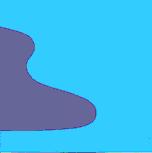 |
A design is placed behind but not touching the silk and the line is traced onto the unpainted white silk with gutta outliner that acts as a resist.
The outliner can be either clear water-soluble gutta, clear spirit based gutta, or permanent coloured, metallic or pearlized gutta. The gutta must be dry before painting the silk.
A hairdryer can be used to speed the drying process.
|
|
Paint or dye is applied to the silk to one side of the resist line. If the area is large, paint will spread more evenly if the silk is first dampened with clean water. A hairdryer can be used to dry the paint.
Paint or dye is applied to the other side of the resist line in the same way. A hairdryer can again be used to dry the paint.
The paint or dye is fixed following the method recommended by the manufacturer and if water-soluble or spirit based gutta has been used the resist line is removed again following the method recommended by the manufacturer.
A line of white unpainted silk is revealed separating the coloured areas.
 |
If coloured, metallic or pearlised permanent gutta was used the coloured resist line will remain separating the painted areas.
